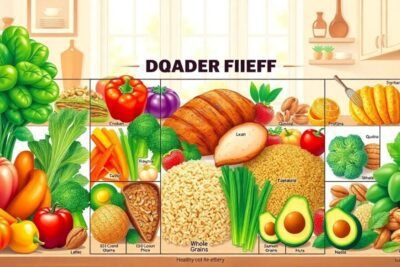
How to lower blood pressure with fast food options
Managing blood pressure is essential for maintaining overall health, especially considering the rising rates of hypertension. Many people often wonder how to lower blood pressure fast food choices can fit into their lifestyle. Understanding how certain foods affect your blood pressure can empower you to make better dietary decisions, even when dining out.
Fast food is often seen as the enemy of healthy eating, but with a few smart choices, it can be incorporated into a blood pressure-friendly diet. Let's explore various strategies, foods, and meal planning tips that can help you lower your blood pressure.
- What are the best foods to lower blood pressure?
- How to lower blood pressure fast with diet?
- What foods should you avoid with high blood pressure?
- How does the DASH diet help lower blood pressure?
- Can you eat fast food if you have high blood pressure?
- What are the key nutrients that help lower blood pressure?
- How to meal plan for healthy blood pressure?
- Related questions about managing blood pressure with food
What are the best foods to lower blood pressure?
When it comes to lowering blood pressure, certain foods can be particularly effective. Incorporating the right foods into your diet can help control hypertension. Here are some of the best options:
- Leafy greens: Foods like spinach and kale are high in potassium, which helps balance sodium levels and reduce blood pressure.
- Berries: Blueberries, strawberries, and other berries contain antioxidants that can improve blood vessel function.
- Bananas: Rich in potassium, they contribute to reducing blood pressure.
- Beets: High in nitrates, beets can enhance blood flow and lower blood pressure.
- Fatty fish: Salmon and mackerel are rich in omega-3 fatty acids, which are known to reduce blood pressure.
Incorporating these foods into your diet can lead to significant improvements in your blood pressure levels, especially when combined with other healthy eating habits.
How to lower blood pressure fast with diet?
Diet plays a crucial role in managing blood pressure levels. Here are practical ways to adjust your eating habits for immediate results:
- Reduce sodium intake: Limiting salt can help lower blood pressure quickly. Aim for less than 2,300 mg of sodium per day.
- Increase potassium-rich foods: Foods high in potassium can help counteract sodium's effects. This includes fruits, vegetables, and dairy products.
- Stay hydrated: Drinking plenty of water helps maintain blood volume and reduces pressure on your blood vessels.
- Eat smaller, frequent meals: This can help regulate metabolism and blood pressure levels.
Additionally, focusing on whole foods while limiting processed items can also be beneficial. A balanced diet rich in fruits, vegetables, whole grains, and healthy fats is key.
What foods should you avoid with high blood pressure?
If you're looking to manage your blood pressure, avoiding certain foods is just as important as knowing what to eat. Here’s a list of foods to avoid:
- Processed meats: Items like bacon, sausage, and deli meats are often high in sodium and unhealthy fats.
- Salty snacks: Chips, pretzels, and popcorn may be tempting, but they can raise your sodium intake quickly.
- High-sugar foods: Sweets and sugary beverages can contribute to weight gain, leading to increased blood pressure.
- Fast food: Many fast food options are high in sodium and unhealthy fats.
Being mindful of these foods can help you make better choices when it comes to your meals.
How does the DASH diet help lower blood pressure?
The DASH diet, which stands for Dietary Approaches to Stop Hypertension, is specifically designed to help manage blood pressure levels. Here’s how it works:
The DASH diet emphasizes a balanced approach, focusing on whole foods such as fruits, vegetables, whole grains, lean proteins, and low-fat dairy. This diet is rich in potassium, calcium, and magnesium, which are essential for heart health. Additionally, it limits saturated fats, cholesterol, and sodium, all of which can negatively impact blood pressure.
Research shows that individuals who follow the DASH diet experience a significant reduction in blood pressure within just a few weeks. This diet also encourages the consumption of foods that provide important nutrients, ultimately supporting cardiovascular health.
Can you eat fast food if you have high blood pressure?
Yes, you can still enjoy fast food even if you have high blood pressure, but it requires making careful choices. Here are some tips:
When ordering, look for options that are lower in sodium and saturated fats. Many fast food restaurants now offer healthier alternatives such as salads, grilled chicken, and whole grain wraps. Opting for smaller portion sizes can also help manage calorie and sodium intake.
Be mindful of dressings, sauces, and extras that can add hidden sodium and calories. Requesting dressings on the side allows you to control the amount used. Additionally, try to balance your fast food meals with plenty of water and potassium-rich snacks throughout the day.
What are the key nutrients that help lower blood pressure?
Certain nutrients are particularly beneficial for maintaining healthy blood pressure levels. Here are the key players:
- Potassium: Found in bananas, oranges, and spinach, potassium helps counteract sodium’s effects on blood pressure.
- Magnesium: Present in nuts, seeds, and whole grains, magnesium supports healthy blood vessels.
- Calcium: Important for vascular health, calcium can be found in dairy products and fortified foods.
- Omega-3 fatty acids: These healthy fats are present in fatty fish and help reduce inflammation and improve heart health.
Focusing on these nutrients in your diet can significantly improve your overall cardiovascular health.
How to meal plan for healthy blood pressure?
Meal planning can be an effective strategy in managing blood pressure. Here are some steps to create a healthy meal plan:
- Start with a variety of foods: Incorporate a mix of fruits, vegetables, whole grains, and lean proteins to ensure a balanced diet.
- Prepare meals in advance: Cooking meals in bulk can save time and help you avoid last-minute unhealthy choices.
- Monitor portion sizes: Keeping an eye on portion sizes can help control calorie intake and manage blood pressure.
- Plan for snacks: Choose healthy snacks like fruits, nuts, or yogurt to prevent unhealthy cravings.
Planning your meals not only helps in controlling your blood pressure but also promotes overall healthier eating habits.
What foods bring blood pressure down fast?
Certain foods can quickly help lower blood pressure. Leafy greens, berries, beets, and bananas are excellent options. These foods contain vital nutrients such as potassium and nitrates that contribute to better vascular health. Incorporating them into your daily diet can lead to noticeable improvements in your blood pressure levels.
Can you still eat fast food with high blood pressure?
Absolutely, you can still enjoy fast food. The key is to make informed choices. Opt for grilled items instead of fried, go for salads with light dressing, and avoid extra sauces. Being strategic about your selections allows you to indulge while keeping your blood pressure in check.
How can I bring my BP down quickly?
To lower blood pressure quickly, consider drinking water to stay hydrated, reducing your sodium intake, and consuming potassium-rich foods. Engaging in light physical activity and practicing stress-reduction techniques such as deep breathing can also help lower your blood pressure effectively.
What can I eat at McDonald's if I have high blood pressure?
At McDonald's, you can choose options like the grilled chicken salad, apple slices, or a fruit and yogurt parfait. Be cautious with dressings, and consider pairing your meal with a water or unsweetened iced tea to keep sodium and sugar levels low.










